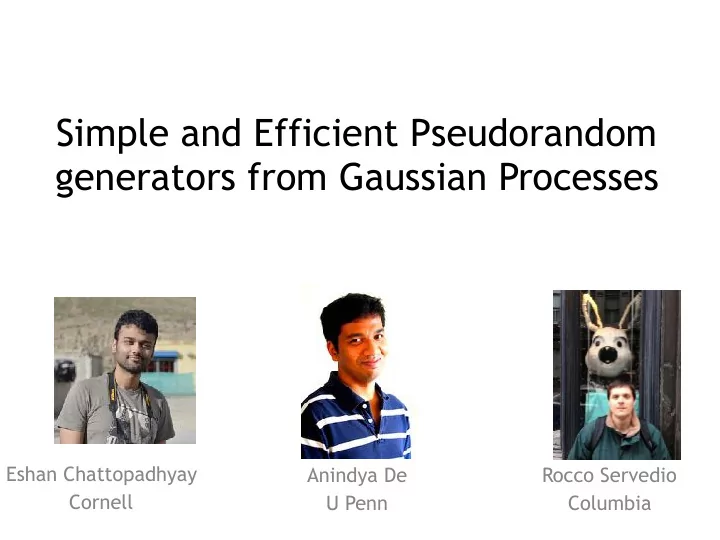

Simple and Efficient Pseudorandom generators from Gaussian Processes Eshan Chattopadhyay Anindya De Rocco Servedio Cornell U Penn Columbia
Halfspaces (aka LTFs) + + + -- + + + -- + -- + -- -- -- + + + -- + + -- -- + -- -- -- + -- -- -- -- --
Halfspaces (and their intersections) + + + + -- + + + + -- + -- -- + -- -- -- -- -- -- -- -- -- -- -- -- -- -- -- -- -- --
Intersections of k-halfspaces • Fundamental for several areas of math and theory CS. • Well investigated in terms of 1. Learning – [Vempala ’10, Klivans-O’Donnell-Servedio ‘08] 2. Derandomization – [Harsha-Klivans-Meka ‘10, Servedio-Tan ‘17] 3. Noise sensitivity - [Nazarov ‘03, Kane ’14] 4. Sampling – [Dyer-Frieze-Kannan ’89, Lovasz-Vempala 04, …]
Pseudorandom Generator (PRG) Let F be a class of Boolean functions ∀ f ∈ F , |E[f(U n )] – E[f(G(U r ))]| < ε
BPP • Languages that admit an efficient randomized algorithm. x ∈ L: Pr[A(x) = 1] > 2/3 x ∉ L: Pr[A(x) = 0] > 2/3
Derandomization via PRGs
Our focus: derandomization • This talk: focus on derandomization in the Gaussian space. • Setup: endowed with the standard normal measure. • Task: Produce a small and explicit set of points such that for (intersection of k LTFs)
Our focus: derandomization Task: Produce a small and explicit set of points such that for (intersection of k LTFs) Non-constructively: of size exists. Best known explicit construction: Harsha-Klivans-Meka gave a construction of size O’Donnell-Servedio-Tan 2019: matching construction w.r.t uniform on Boolean cube
Our main result An explicit construction for fooling intersection of k- halfspaces on the Gaussian measure whose size is ➢ Our construction has polynomial size for ➢ Arguably much simpler construction.
Connection to Gaussian processes • Connection is an overstatement -- it’s a simple rephrasing. • Instead of looking at AND of halfspaces, let us look at OR of halfspaces. max/sup of Gaussian processes
Main idea • We are interested in studying a non-smooth function of the supremum of Gaussian processes. • We are interested in producing a small set so that
Setting sights lower • What if we want to produce such that • Recall: statistics of Gaussian process governed by mean and covariances -- determined by • Johnson-Lindenstrauss can preserve covariances approximately by projecting on to random subspaces.
Johnson-Lindenstrauss • Strategy: Sample a random low-dimensional subspace H . • Sample from H. Call this distribution Question: (i) Mean / covariance of the distributions Does this imply
Preserving expected maxima • Yes – Sudakov-Fernique lemma (quantitative version by Sourav Chatterjee) • Randomness complexity of sampling from a random low- dimensional subspace H ? • JL can be derandomized (Kane, Meka, Nelson – 2011) – in particular, random projection from n to m dimensions can be replaced by a set of size
Preserving expected maxima Lemma: Let and be two sets of normal random variables with a. , b. . Then, In a nutshell: To get non-trivial approximations, we only need . This can be achieved by random projections to dimensions.
Preserving expected maxima Lemma: Let and be two sets of normal random variables with a. , b. . Then, Main thing we need to do: Prove the same for vis-à-vis
Quick proof sketch Main trick: Consider smooth maxima function instead of maxima. Define the function Fact: Much easier to work with the smooth function
Stein’s interpolation method • Comparing the quantities and : • Condition: have matching means and nearly matching covariances. • For , define
Key statement Lemma: Proof is based on Stein’s formula (integration by parts) and some algebraic manipulations. One useful fact:
Putting things together
Our goal • Recall: We want to prove • Two step procedure: • Prove for smooth F The error bound depends on derivatives of F .
Going from smooth to non-smooth • To go from smooth test functions to non-smooth test functions, the random variable should not be very concentrated. -1 0 1
Going from smooth to non-smooth • Suppose are (potentially correlated) normal random variables with variance 1. • How concentrated can be? • Easy to show: • Much harder [Nazarov]:
Putting it together • Anti-concentration bound allows us to transfer bounds from smooth test function to the test function . • This proves that
Summary • If we start with a set of jointly Gaussian random variables , and do a (pseudo) random projection to obtain => JL implies means and covariance preserved. • Sudakov-Fernique: • This work, we exploit:
Other results • What other statistics of Gaussians can be preserved by using random projections? • If and have - matching covariances, • Proof: closeness in covariance ➔ closeness in Wasserstein ➔ closeness in union of orthants distance (Chen- Servedio-Tan) • PRG for arbitrary functions of LTFs on Gaussian space with seed .
Other results • Deterministic Approximate Counting: – poly(n) 2 poly(log k, ε ) time algorithm for counting fraction of Boolean points in a k-face polytope, up to additive error ε . – poly(n) 2 poly( k, ε ) time algorithm for counting fraction of Boolean points satisfied by an arbitrary function of k halfspaces, up to additive error ε . • Technique based on invariance principles and regularity lemmas. – Beats vanilla use of a PRG that brute-forces over all seeds!
Open questions • PRGs for fooling DNFs of halfspaces using similar techniques? • Extending techniques to the Boolean setting?
Recommend
More recommend